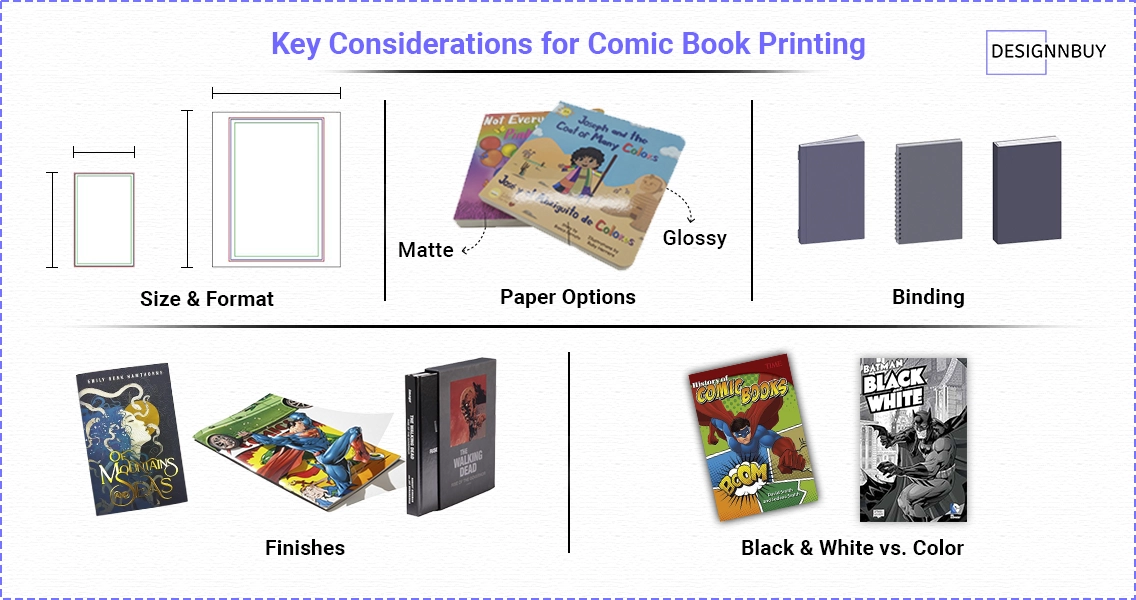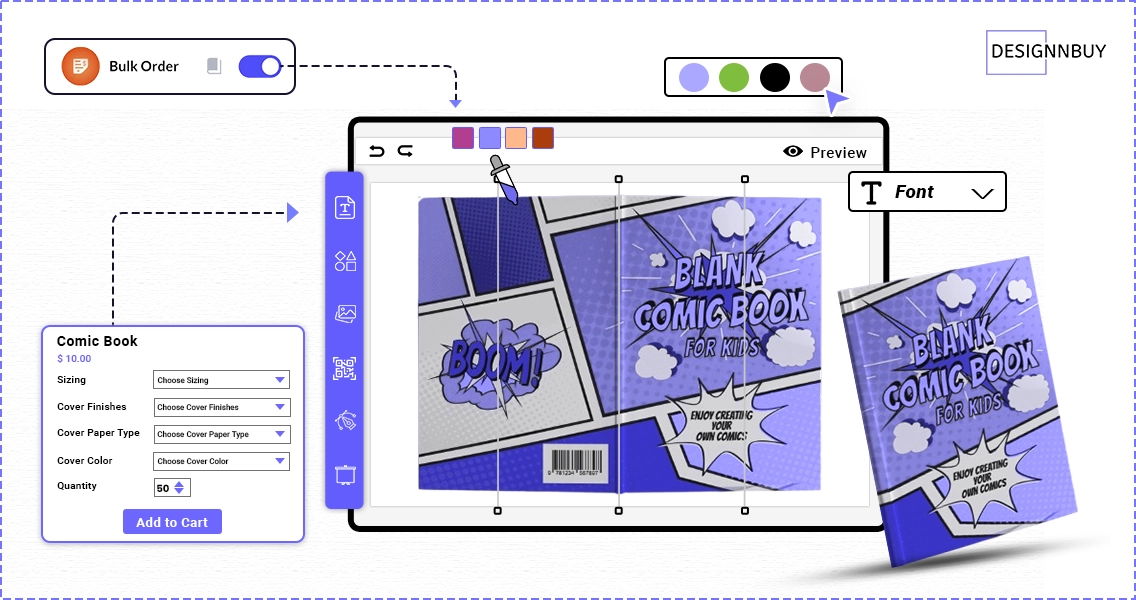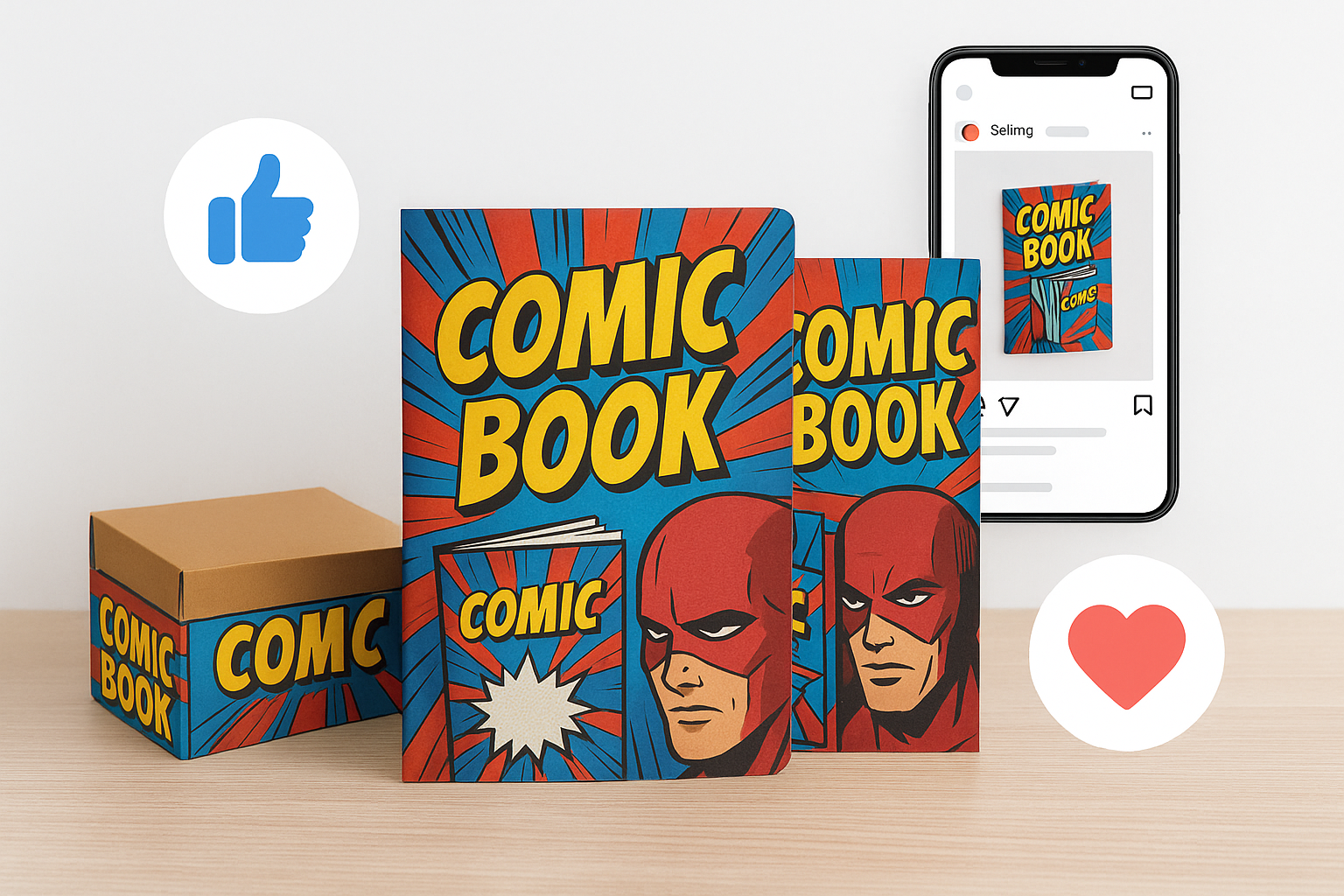What do manga, Marvel, and indie webcomics all have in common? They’re fueling a global appetite for printed comic books, and it’s only getting bigger.
While digital comics are on the rise, most fans and collectors still prefer physical copies. The feeling of the paper, the vivid colors, the joy of flipping through pages, are all part of the comic experience.
And the numbers don’t lie. The global comic book market is expected to hit $3.34 billion by 2029, with print editions continuing to dominate overall sales.
That’s a massive opportunity especially if you’re a print business owner looking to expand your offerings.
In recent years, self-publishing, crowdfunding platforms like Kickstarter, and a wave of independent artists have reshaped the comic industry. Thousands of creators are now looking for trusted partners to help them bring their stories to life in print.
But they don’t have the tools, equipment, or print expertise. You do.
With the right setup, online ordering, preflight tools, customization options, and fast fulfillment, you can become the go-to comic printing partner for creators around the world.
Whether you’re based in the USA, Canada, Europe, the Middle East, or APAC, this guide will show you how to tap into the growing demand for comic book printing online and turn it into a scalable, profitable part of your business.
Let’s get in and take your print business’s next big growth channel: custom comic book printing.
Table of Contents
Why Comic Book Printing Requires a Specialized Approach
Comic books are more than just printed pages, they’re collectible works of art. From paper stock to finishing touches, every detail impacts how a comic is experienced.
If you’re offering comic book printing online, here’s what makes it different and how to get it right.
Popular Comic Book Sizes and Formats You Should Offer

Support the most in-demand comic book sizes to serve all kinds of creators:
- US Standard Comic Size – 6.625″ × 10.25″
(Perfect for superhero and western-style comics)
- Manga Size – ~5″ × 7.5″
(Popular for Japanese-style or indie comics)
- European Album Size – ~8.4″ × 11.6″
(Used for premium graphic novels and illustrated stories)
You can also offer square sizes or custom dimensions for webcomic anthologies and fan-made zines.
Pro tip: Add downloadable templates with proper bleed and margin guides to make life easier for creators during the file upload stage.
Best Paper Types for Printing Comic Books
Comic book readers notice the feel and finish of every page. That’s why your paper options matter just as much as your print quality.
- Interior Pages:
70–80 lb text (105–120 gsm), matte or gloss finish, coated or uncoated depending on the visual style.
- Covers:
100–110 lb cover stock (157–200 gsm), with optional lamination or soft-touch finishes for added durability and luxury.
Sustainability matters too. Many indie creators prefer recycled paper to align with eco-conscious branding.
Binding Options for Custom Comic Book Printing
Not all comics are created equal, some are short-form zines, others are 300-page graphic novels. Offer a range of binding options based on length and style:
- Saddle-Stitched (Stapled):
Ideal for comics up to 64 pages. Budget-friendly and perfect for floppies or limited editions. - Perfect Bound (Softcover):
Great for thick comics or graphic novels with a spine. Adds a premium feel without the hardcover cost. - Hardcover (Case Bound):
The go-to for collectors and crowdfunded projects. Durable and high-end, perfect for creator portfolios or special releases.
Use clear visuals or mockups to help customers understand what each binding looks like in real life.
Color vs. B&W Comic Book Printing
While full-color comics are standard in superhero and kids’ genres, black-and-white styles remain popular in indie, horror, and manga formats. Give your customers the flexibility to:
- Upload black-and-white interior pages and color covers
- Preview both styles live in your web-to-print editor
- Mix formats for artistic or budget reasons
Add Premium Finishes to Boost Comic Book Value
If you really want to stand out, offer premium finishing touches that take a comic from ordinary to unforgettable:
- Spot UV – Adds shine and contrast to cover titles or logos
- Foil Stamping – Metallic accents for logos or signatures
- Embossing – Creates tactile depth and dimension
- Soft-Touch Lamination – Adds a velvet-like feel to covers
These finishing options aren’t just aesthetic, but they help your customers create limited editions, justify higher prices, and wow their fans. Highlight these as upsells on your product pages and let customers select them in real-time using your web-to-print configurator.
How to Identify and Target Comic Book Creators for Your Print Business
Before you start building your web to print storefront or promoting your comic printing services, take a step back and ask: Who exactly are you printing for?
The answer isn’t just “comic creators.” It’s a diverse mix of passionate individuals and small teams each with different needs, budgets, and workflows. Knowing your audience will help you design the right experience, products, and pricing model.
Here are the four core types of customers your print shop can attract when offering comic book printing online:
1. Independent Comic Creators
These are solo artists or writer-illustrator duos bringing their original characters and stories to life. They’re often publishing their first few issues or creating one-shot graphic novels.
What they’re looking for:
- Low minimum order quantities (10–100 copies)
- Affordable, high-quality printing
- A guided design tool or templates to help with file setup
- Eye-catching finishes to boost the wow factor
2. Crowdfunded Creators (Kickstarter, Indiegogo, etc.)
These creators have pre-sold their comics through crowdfunding and are now fulfilling hundreds or even thousands of orders. Their project is already funded, they just need a reliable printer to deliver.
What they’re looking for:
- Bulk pricing with volume discounts
- Flexible turnaround times
- Proofing tools and 3D previews for transparency
- Multiple binding and finish options (especially for stretch goals)
- Split-shipping or worldwide fulfillment
Add a “Kickstarter Fulfillment” package to your printing storefront and highlight how you handle everything from design proof to doorstep delivery.
3. Webcomic Artists Going to Print
These creators have built a loyal fanbase by publishing digital comics on platforms like Tapas, Webtoon, or Instagram and now want to sell physical versions as merch or art books.
What they’re looking for:
- Print-on-demand with no upfront investment
- A sleek, modern web to print storefront with online customization
- Compact formats (e.g., square or manga size)
- High-quality color output for rich illustrations
If you use DesignNBuy’s Booklet Design Software, you can give them real-time previews of each page and let them design directly in-browser without needing InDesign or Photoshop.
4. Educators, Students & Hobbyists
From schools and libraries to fan artists and zine creators, many people want to create short-run comics for fun, education, or personal storytelling. They may be first-time users unfamiliar with print specs.
What they’re looking for:
- Simple templates and beginner-friendly tools
- Affordable pricing for low-volume orders
- Visual examples (mockups, sample books)
- Supportive customer service
Add a “Make Your First Comic” page that walks them through file setup, paper selection, and ordering in just a few clicks.
How to Build an Online Printing Storefront for Comic Book Printing
Your printing storefront is more than just a website, it’s your virtual showroom, your order desk, and your sales rep all rolled into one.
If you’re serious about selling comic book printing services online, your site needs to do more than list products. It must speak directly to the needs of comic creators and offer a smooth, intuitive journey from idea to checkout.
Let’s break down what your storefront should include:
1. Clear Navigation with Creator-Focused Paths
Don’t just lump comics under “booklets” or “miscellaneous.” Create a dedicated “Comic Printing” category with sub-sections like:
- Print Your Comic
- Graphic Novels
- Manga & Webcomics
- Crowdfunded Projects
- First-Time Creators
Each path should include relevant formats, pricing options, FAQs, and design tools. The more relevant it feels, the more likely a creator will stick around and order.
2. Visual Product Mockups That Inspire Confidence
Creators are visual people. They want to see what their finished comic will look like. Use high-quality mockups of:
- Saddle-stitched and perfect-bound comics
- Glossy and matte finishes
- B&W and full-color interiors
- Softcover vs hardcover options
- Special finishes like spot UV or foil stamping
Bonus: With DesignNBuy’s 3D preview feature, you can let customers interact with a virtual version of their book, flipping through pages and rotating the cover before ordering.
3. Real-Time Pricing & Customization Options
Comic creators love to experiment with page counts, paper stock, finishes, binding. Your web to print storefront should let them build their comic in real time and see the cost update instantly.
With web-to-print platform, customers can:
- Choose size, binding, and finishes
- Add or remove pages
- Upload print-ready files or use the built-in design tool
- See live pricing, proof previews, and order summaries
This not only increases conversion but also reduces errors and manual quote requests.
4. Built-in Design & Proofing Tools

Many creators don’t have design software or print experience. That’s why offering an integrated, browser-based booklet design software is a game-changer.
Let users:
- Start from scratch or use page templates
- Drag and drop panels, art, and text
- Design their front and back covers
- See live bleed warnings and export a final proof
With DesignNBuy’s Booklet Design Software, you give them everything they need to design, preview, and submit a flawless comic without extra support from your team.
5. Seamless Checkout, Shipping, and Fulfillment
The final step should feel just as smooth.
- Offer flexible shipping (domestic, international, bulk, drop-ship)
- Enable tracking updates via email or account dashboards
- Clearly show estimated turnaround times
If you’re offering print-on-demand, note that prominently. Creators love the idea of printing only what they sell, especially webcomics and small-run series.
And if you serve creators in multiple regions (US, Canada, Europe, APAC), consider setting up regional storefronts or dynamic shipping calculators.
6. Add FAQs, File Guidelines, and Creator Support
Educate your customers. Make them feel empowered. Add:
- Clear file upload specs (PDF/X-1a preferred? 300 DPI? CMYK?)
- Page setup guides for each size
- Binding/paper finish comparison tables
- Answers to questions like “Can I print just 25 copies?” or “Will you check my file before printing?”
How to Market Your Comic Print Services and Get Found by Creators Online
Reach the right creators, at the right time, with the right message
You’ve got the web to print storefront. The design tool. The killer print quality. But how do you get comic creators to find you?
Unlike traditional B2B print clients, comic creators hang out in niche communities, follow specific trends, and look for vendors who get their world. So your marketing needs to be targeted, creative, and creator-friendly.
Let’s break down how to get discovered, build trust, and grow your comic printing business online:

1. SEO for Comic Book Printing Services
When creators search Google for “comic book printing” or “Kickstarter comic printer,” your site should be front and center.
Optimize for keywords like:
- comic book printing online
- manga printing services
- short run comic printing
- Kickstarter comic fulfillment
- custom graphic novel printing
Include these in:
- Page titles & meta descriptions
- Product descriptions & category names
- Blog content & FAQs
- Image ALT tags (mockups, binding examples, etc.)
Pro tip: Add helpful articles like “How to Prepare Your Comic Book for Print” or “Comic Book Paper Types Explained” to attract long-tail traffic and build authority.
Bonus: Looking to win more comic book clients? Join our digital marketing BootCamp made for print shops like yours.
2. Be Where the Creators Are: Online Communities & Platforms
Most creators aren’t Googling random printers but they’re asking in forums, subreddits, and Discord groups. They’re on platforms like:
- Reddit: r/ComicBookCollabs, r/ComicBookPublishing
- Discord: Indie comics creator servers
- Facebook groups: Comic creators, zine makers, webcomic communities
- Kickstarter & Indiegogo: Following active projects
- Webtoon & Tapas: Connecting with creators making the jump to print
Join the conversation without being salesy. Offer helpful advice, link to free guides, and build your name as the go-to comic printing partner.
3. Run Targeted Ads (That Don’t Feel Like Ads)
Use paid ads sparingly but smartly. Target based on niche interests like:
- “Comic creator”
- “Zine maker”
- “Graphic novel”
- “Webcomic artist”
- “Kickstarter campaign”
Platforms to try:
- Instagram (carousel ads showing mockups + finishes)
- Facebook (target creators by interests + pages followed)
- Google Ads (target search terms like “print my comic book”)
- YouTube (sponsor or run pre-rolls on comic creator channels)
4. Partner with Creators & Influencers
Creators trust other creators. Partner with a few micro-influencers in the comic space to test your platform, review your samples, or share the print experience with their followers.
Ways to collaborate:
- Sponsor their next comic print run
- Offer exclusive promo codes
- Send out free print sample packs in exchange for honest feedback
- Get featured in comic printing recommendation videos or blogs
5. Go Offline: Events, Cons, and Print-Ready Kits
Comic creators don’t just live online but they show up at cons, zine fests, artist alleys, and local expos.
If you attend or sponsor:
- Bring sample books, mockups, and promo kits
- Offer “creator print starter kits” with paper swatches, templates, and coupon codes
- Print badges, lanyards, or mini booklets to showcase your quality
Ready to Sell Comic Books and Grow Your Print Business?
The world of comics is changing fast, what used to be limited to publishers and distributors is now being led by independent creators, crowdfunders, and digital-first artists turning their stories into beautiful printed books.
What hasn’t changed is the love for print. Comic fans want something they can hold, flip through, and proudly display. And creators? They’re looking for trusted partners who can make that possible without headaches.
That’s where today’s print businesses have a unique edge.
If you can offer the right sizes, paper types, bindings, finishes, and easy online ordering, you’re not just a printer. You become part of the creative process. You help artists bring their worlds to life and that’s powerful.
Platforms like DesignNBuy are making it easier than ever for print shops to serve this audience. From built-in booklet design tools to a fully customizable storefront, you can create an experience that speaks directly to comic creators, while automating your backend and scaling your operations globally.
Whether you’re printing your first 50 floppies for a local artist or fulfilling a 2,000-copy Kickstarter campaign, now is the time to position yourself in this fast-growing niche.
So the next time someone searches “print my comic book,” make sure they find you and everything they need.
Ready to Grow Your Comic Printing Business?
We can help you attract more creators, sell online, & scale your business
FAQs
What’s the minimum quantity I should offer for comic book printing?
Most indie creators look for short runs as low as 10 or 25 copies. If your setup allows, offering low minimums helps you attract more first-time and hobbyist customers. You can scale up with volume discounts for larger runs (100–1000+).
Do I need a special press for comic books?
Not necessarily. If you already print catalogs or booklets, you likely have the equipment needed. The key differences are paper type, ink coverage, and finishing. Make sure your press handles full-bleed color and saddle-stitch or perfect binding reliably.
How do I reduce print errors and reprints?
Use a web-to-print platform with built-in preflight tools, like DesignNBuy. It ensures files meet resolution, bleed, and color space standards before going to press. You can also require print-ready templates and show live previews.
Can I let customers design their comics directly on my website?
Yes! With DesignNBuy’s Booklet Design Software, customers can design, edit, and preview their comic pages and covers in real time with no third-party software needed. It’s a game-changer for creators who don’t use InDesign or Photoshop.
How do I handle international shipping for comic orders?
You can offer print-on-demand with region-based fulfillment or integrate global shipping plugins in your storefront. DesignNBuy supports multi-location production and integrates easily with logistics providers.
Looking for more? Check out our other blogs:
5 Essential Web To Print Features for Online Booklet Printing & Publishing Businesses
Offline vs. Online Custom Notebook Printing Business: Why You Should Go Digital
How to Sell Custom Notebooks Online: A Web to Print Storefront Guide
Selling Custom Spiral Notebooks Online in Your Web to Print Store 2025




